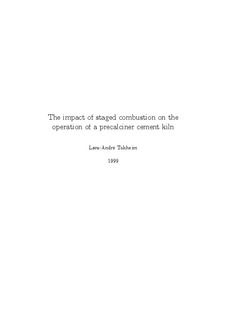| dc.description.abstract | In this thesis, the impact of staged combustion on the operation of a precalciner cement kiln, is considered. Mathematical modelling and full-scale experiments at the Norcem cement works in Brevik, Norway, is the basis for the thesis. The goal of the work was to characterize and explain operational disturbances related to the application of alternative solid fuels in staged combustion, and to take actions to avoid such disturbances. A mass and energy balance of a precalciner cement kiln system, Mebcem, was implemented in Matlab, and used as a tool for analysis of the kiln system, planning of experiments and interpretation of experimental data. The mass balance was calibrated and validated by means of process data collected during tests. Full-scale experiments using plastic as reburning fuel in the kiln inlet proved a NOx reduction potential of about 40 %. However, operational disturbances related to an alteration of the internal material cycles in the kiln system, were also experienced. To be able to analyse the sulphur chemistry at the kiln inlet, a program for the calculation of thermodynamic equilibria, Seacem, was implemented in Matlab. The thermodynamic analysis indicated that contact between fuel, precalcined meal and kiln gas caused the operational disturbances. This was supported by thermogravimetric analyses. Furthermore, CFD calculations conducted with FluentR, and laboratory experiments carried out to determine the entrainment velocity of various alternative fuels, demonstrated that, in the kiln system that was studied, such contact is hard to avoid. Based on these findings, a mechanism explaining the phenomena observed in the experiments was suggested, and a re-location of the feeding point for alternative fuels was prescribed. In subsequent experiments with a new feeding point location where precalcined meal, reburning fuel and kiln gas was not brought into simultaneous contact operational impacts were avoided or strongly reduced. However, the NOx reduction efficiency was at the same time reduced to about 20 %. One trial with so-called lean reburning was conducted. Whole car tyres were fed to the rotary kiln, and a 25 % reduction in NOx emissions was demonstrated by this technique. As part of the experimental program, the distribution of sulphur, sodium, potassium and chlorine all circulating elements in the kiln system, was determined. This was achieved by analysing a large number of meal and gas samples from the process, in combination with a program for the calculation of internal material cycles, Circcem, implemented in Matlab. For S, K and Na, the balance errors were in the interval 5-7 %, while the chlorine imbalance was much larger. The very intense circulation of chlorine explains why it is difficult to obtain a material balance for chlorine in a cement kiln system. A procedure for optimizing the degree of sulphatization of the alkalis in the clinker was also developed. By means of this procedure it is possible to control the internal material cycles of the kiln system, and hence have an improved basis for staged combustion. | |
